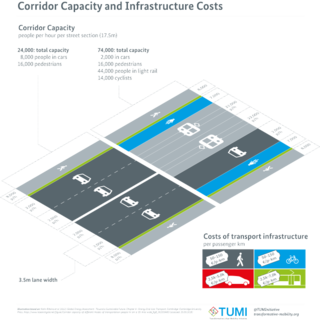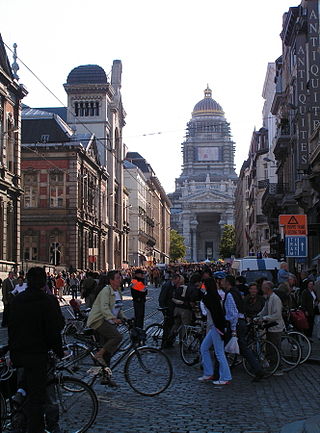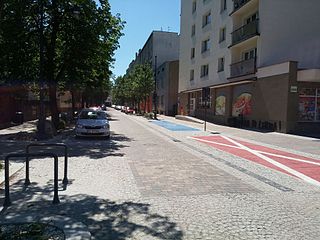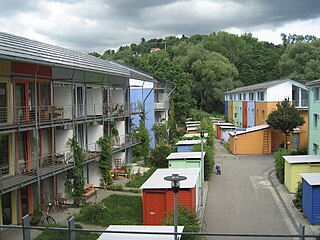
This is a list of pedestrian zones: urban streets where vehicle traffic has been restricted or eliminated for pedestrian use only. [4] These are usually pedestrianised urban centres of a city, town or district with a residential population that have been retrofitted. [5]
| Country | Location | Details |
|---|---|---|
| Armenia | Yerevan | Northern Avenue, located in the Kentron district of central Yerevan, is a large pedestrian avenue. The avenue was inaugurated in 2007 and is mainly home to residential buildings, offices, luxury shops and restaurants. [6] |
| Australia | Melbourne | Several areas within the Melbourne CBD, [7] including the Bourke Street Mall, Swanston Street, [8] Block Arcade, Royal Arcade, Degraves Street, Queen Victoria Village, City Square and Federation Square |
| Australia | Perth | Hay Street in the Perth CBD became the first pedestrianised street of any Australian major capital in 1972 [9] |
| Australia | Sydney | Within the Sydney CBD, George Street was pedestrianised between Bridge Street and Hay Street in stages between 2021 and 2023 [10] [11] |
| Belgium | Brussels | Europe's largest pedestrian zone (French: Le Piétonnier), established in phases starting in 2015 and set to cover 50 hectares (120 acres). The area covers much of the historic centre within the Small Ring (the ring road built on the site of the 14th century walls), including the Grand-Place, the Place de Brouckère/De Brouckèreplein, the Boulevard Anspach/Anspachlaan, and the Place de la Bourse/Beursplein. [12] [13] |
| Germany | Freiburg im Breisgau | Large car-free centre (610 x 720 m). Medieval university town. Minimal car traffic is permitted on some streets. Trams provide access. Progressively pedestrianised since 1971. [14] The neighbourhood of Vauban is considered the prototype for the Vauban model of transport planning. Some streets are "parking-space-free" (German : stellplatzfrei, rather than "car-free". [15] |
| Germany | Munich | The Kaufingerstraße and Neuhauser Straße through the historic city center from Marienplatz to Stachus were pedestrianized on June 30, 1972 in time for the 1972 Summer Olympics. [16] In 2019, the Sendlinger Straße was pedestrianized from Marienplatz to Sendlinger Tor. [17] |
| Italy | Venice | The historic centre (Italian : centro storico) of Venice is divided in six sestieri ("districts") with a combined area of 7.9796 km2 (797.9631 ha; 7,979,631 m2). [1] Of its 129 islands, [2] Tronchetto, Santa Chiara (which contains the Port of Venice) and the Piazzale Roma bus station square in the Santa Croce sestiere are the only islands where automobiles and busses are permitted within the historic centre; [3] these three jointly cover 711,339 m2 (71.1339 ha; 0.711339 km2). [2] The rest of the Venetian Inner Islands are a pedestrian zone covering 7.268261 km2 (726.8261 ha; 7,268,261 m2; c. 91% of the historic centre), [1] [2] where transport takes place on foot or by water (gondola). [3] |
| Kazakhstan | Almaty | The Arbat, one of Kazakhstan's most popular and first pedestrian zones in Almaty, was established in Jibek Joly Street in the late 1980s. The area is lined with many shops and kiosks, as well as local artists selling their work. [18] |
| Morocco | Fez | Fes el Bali, the larger of the two medieval medinas, consists of narrow streets that are inaccessible by automobile. A few access streets for emergency vehicles are being built. [19] [ self-published source? ] |
| Morocco | Marrakesh | The historic souks (marketplaces) in the city centre are a car-free zone. The streets are only narrow enough for pedestrians, cyclists or motorcyclists. The surrounding medina was designated a UNESCO World Heritage Site in 1985. [20] |
| Netherlands | Arnhem | The pedestrian zone (Dutch : voetgangersgebied) covers the area within the boundaries of the following streets and squares: Nieuwe Plein, Willemsplein, Gele Rijdersplein, Looierstraat, Velperbinnensingel, Koningsplein, St. Catharinaplaats, Beekstraat, Walburgstraat, Turfstraat, Kleine Oord, and Nieuwe Oeverstraat. [21] |
| Netherlands | Utrecht | The pedestrian zone gradually grew over the years. As of 1 August 2022, it covers the following streets and squares: Lijnmarkt, Choorstraat, Oudegracht Westzijde until Lange Viestraat, Boterstraat, Steenweg, Lange and Korte Elisabethstraat, Vredenburg, Donkerstraat, Mariastraat, Achter and Voor Clarenburg, Zakkendragerssteeg, Drieharingstraat, Hamsteeg, Bakkerstraat, Lauwersteeg, Hekelsteeg, Massegast, Vinkenburgstraat, Neude, Schoutenstraat, Oudegracht Oostzijde from Hamburgerbrug, Lichte en Donkere Gaard, Vismarkt, Stadhuisbrug, Ganzenmarkt, Wed, Oudegracht Oostzijde until Potterstraat, Drakenburgstraat, Servetstraat, Zadelstraat, Buurkerkhof, Hollandse Toren, Vlaamse Toren, Vredenburgkade, Rijnkade. [22] |
















